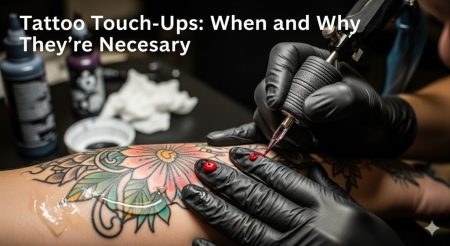Tattooing is one of the most well-known and revered forms of body modification in the world. It is a permanent art made on the skin that consists of a subcutaneous application obtained through the introduction of pigments by needles. Despite being a very common practice, it presents some health risks. Also, care and specific preparation is needed to get a tattoo.
The English word tattoo is derived from tatau, the Samoan term that mimics the tapping sound of the tools used to make a tattoo.
Origin of tattoo
Getting a tattoo is not a new fad. It is not known for sure when the practice began, but one of the oldest records was seen in the famous Ice Man – a mummy approximately 5,300 years old. Female Egyptian mummies, such as Amunet, have traces and dots written on the abdomen, indicating that tattoos in Ancient Egypt could be related to fertility cults.
Even with so many uncertainties, scholars agree that the tattoo must have emerged in the quest to try to preserve body painting. The practice spread across all continents, with different purposes: religious rituals, identification of social groups, marking prisoners and slaves, ornamentation, and even camouflage.
In the West, the technique fell into disuse with Christianity, which banned it. The tradition was only rediscovered in 1769 when the English navigator James Cook carried out his expedition to Polynesia and recorded the custom in his logbook: “Men and women paint their bodies.
One hundred years later, Charles Darwin claimed that no nation was ignorant of the art of tattooing. In fact, from Native Americans to Eskimos, from Malaysia to Tunisia, most people on the planet practiced or had practiced some type of tattooing. With the invention of the electric tattoo machine in 1891, the habit spread even further across Europe and the United States. By the end of the 20th century, designer fur, until then an almost exclusive feature of sailors and convicts, had become one of the most enduring youth fashions.
How is a tattoo done?
A tattoo is done by applying ink to the area of skin known as the dermis, which is located below the outermost layer of the skin, the epidermis. The ink is injected through fine needles that penetrate about 2 mm of the skin until reaching the proper location. It is important that the ink is placed in the right location to prevent the tattoo from being removed. If the ink were placed superficially, the skin peeling process would lead to the elimination of the tattoo.
Who invented Tattoo Machine:

In 1891, Samuel O’Reilly developed an electric device to make tattoos, based on another extremely similar tool, a perforation pen, which had been created and patented by Thomas Edison, the creator of the electric light bulb. At first, the pen wasn’t made to draw on human skin, but Samuel made some modifications, in addition to adding an ink reservoir.
Steps for getting a tattoo
To get a tattoo, certain steps must be followed. The first step is to clean the place where it will be done, removing all the hair in the region. Some professionals recommend that the depilation be done at least two days before the process to avoid information.
Before starting the tattoo, it is essential to disinfect the area that will be tattooed. The same should be done with the tattoo artist’s hands before putting on the glove. Furthermore, before starting the process, it is important to check whether the needles are disposable or have been sterilized in an autoclave and whether the inks have their original labels.
After the area is completely cleaned and the material checked, the transfer phase of the design to be tattooed begins. The technique called decal allows the contours to be made to remain on the skin in order to guide the tattoo artist’s work. Once this is done, ink injection begins.
Once the tattoo is finished, it is important to bandage the area. Approximately three hours after making the drawing, it is necessary to wash the area with running water and neutral or antiseptic soap. After cleaning, it is essential to apply healing ointment and redress the dressing. It is recommended to apply the dressing for two days at least four times a day. After that time, the recommendation is to use only the healing ointment.
Healing
Depending on the size and style of the tattoo , it may take some time to heal. However, it is common for the process to last at least six months. The first layer of skin, the visible one, however, heals within two or three weeks after the session.
Major tattoo risks
The main risks of getting a tattoo include:
Infections
It is common for parents to tell their children about the risks of infections, but the relationship with diseases such as hepatitis C is more widespread than many people think. A study in the journal Hepatology found that tattooed people are four times more likely to have the disease.
Allergic reactions
It’s not every time that little allergy will disappear overnight. The most common reactions come from the ink’s pigments and can persist for months and even years.
Mysterious inks
Nowadays, many of tattoo inks contain organic azo dyes with plastic -based components – this is very common in other fields (clothing and car inks). The worst thing is that it is not known very well what the reaction of these components in contact with the skin or the body in general is
Dibutyl phthalate
Dibutyl phthalate is a plasticizer found in nail polish and is responsible for the durability of the product. It has adverse effects on long-term exposure and is quite troublesome for human health.
Polycyclic aromatic hydrocarbons
A 2010 study found combustion products known as polycyclic aromatic hydrocarbons in different dark paints. One such component is known as a skin cancer enhancer, used in animal research.
Precautions when getting a tattoo
To reduce the risk of complications, it is important to take care after getting a tattoo, such as:
- Demand that all material be new and disposable, avoiding materials that are sterilized and reused;
- Prefer small and black tattoos;
- Do not tattoo over moles or stains, as this may make it difficult to see any changes in the size, shape or color of the mole;
- Apply a healing ointment or cream after the procedure and for 15 days;
- Avoid some types of food, such as fried foods, sausages, ham, sweets and seafood, as they can harm the healing of the tattoo;
- Apply a good layer of sunscreen whenever you expose yourself to the sun to protect your skin and prevent the tattoo from fading;
- Do not go to the beach or pool in the first two months to reduce the risk of infections;
- Do not donate blood for one year after getting a tattoo .
When observing any changes in the place where the tattoo was made , consult a doctor or a doctor.






